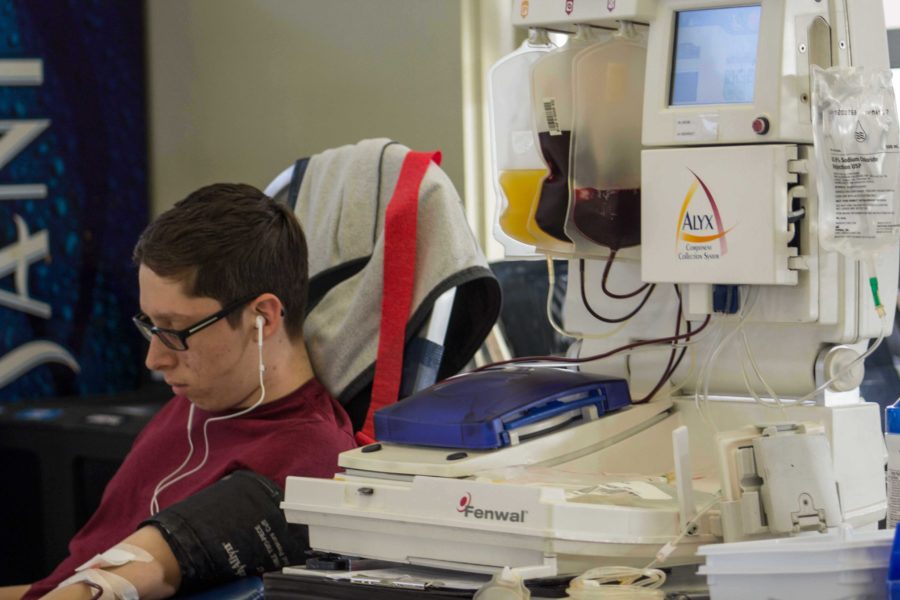Stopping the Bleeding–For Good Reason
Gabriel Martin, senior, donating his blood at the annual United Blood Services Blood Drive.
Over 200 Cam High students band together every year to donate their blood to potentially save the lives of others. Some conquer a fear of needles to help those in need, while others are barred from donating altogether, sparking widespread frustration despite the good intentions of the guidelines.
The first phase of Cam High’s semi-annual blood-drive occurred in the school cafeteria on Dec. 13 and 14 throughout the school day. Students can participate through walk-in appointments or by signing up in Mrs. Mary Harris, school nurse’s office. They must receive parental permission if they are under 18 by having their parent or guardian sign a waiver accepting the risks. A total of 197 students signed up to donate blood this year, but this number does not reflect the number of walk-ins. Cam High has brought in an average of 220-230 units of blood over the past few years.
However, there are several reasons why a person may be turned down from a blood donation. The reasons vary from diseases found in the potential donor’s blood, like HIV or AIDS, to things that may put the donor in danger, such as hemophilia, a condition in which the blood has difficulty clotting and closing wounds.
The restrictions that have caused the most distress, however, are the height and weight requirements. For many, these requirements are out of their range, resulting in widespread disappointment among potential donors when they can’t be a part of the service. Some students wish the guidelines were easier to attain for those just under the required weight of their height bracket.
“I just don’t understand how they can expect someone who is 5’1″ to be 130 pounds,” said senior Jacqueline Cisneros, who had always wanted to donate blood. Cisneros was unable to donate blood because she didn’t fit the weight requirement. “It was one of my goals from freshman year- to donate at least once.”
The blood donation requirements are as follows- males between the ages of 16 and 22 must be five feet and at least 110 pounds, and females must be five feet, six inches and 110 pounds. If a female is shorter than that, she must refer to the following information. A woman may be –
Health professionals assure the students that the guidelines are exactly what they need to be and for good reason. “On average, a person has eight to ten units of blood, and someone on the smaller end would have less blood,” said Cam High nurse Mrs. Mary Harris. “The concern is that they would be taking blood from someone already low on it.”
A common misconception about blood donation is that the blood will regenerate regardless of how much is lost; however, there are two potential complications that may take place before the donor’s body can recuperate.
If someone not meeting the requirement manages to donate blood by lying about their weight, a vasovagal reaction, an involuntary reflex in the nervous system upon the loss of blood, is the primary concern. During this reaction, the heart slows while blood vessels in the legs dilate, resulting in the heart pumping out less blood which leads to a drop in blood pressure. Blood then rushes to the lower extremities, leaving the brain with a lack of oxygen and may lead to fainting and minor hypoxic brain damage.
If an underweight donor avoids a vasovagal episode, they may experience fatigue, irregular heartbeat, shortness of breath, dizziness, chest pain, or headaches. These symptoms are signs of anemia, or the lack of healthy red blood cells to take in adequate oxygen to the body’s tissues. This condition can be long and short term and can lead to heart conditions or failure and severe fatigue.
While the height and weight requirements currently in place may be unobtainable for some, they are put into place for the donor’s safety. For more information, you can visit the United Blood Services website at unitedbloodservices.org.
The semi-annual blood drive provided by United Blood Service at Cam High will also take place in the week after Advanced Placement testing in May.
Updated: According to United Blood Services, Cam High students donated a total of 251 units of blood over the two-day event. Out of the 257 donors who checked in, 202 were allowed to donate this year.

Hi, I'm Haelley.
My name is spelled kind of funny, I know, it's Irish. But I hope one day it will be better known because I want to become a published...

















































































![Senior Ditch Day... Relaxation or Truancy? [Video]](https://achsstinger.com/wp-content/uploads/2017/10/IMG_7119-900x599.jpg)
![Heavy Rain Hits Cam High [video]](https://achsstinger.com/wp-content/uploads/2017/02/maxresdefault-900x506.jpg)




